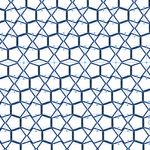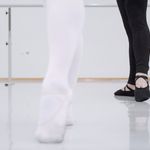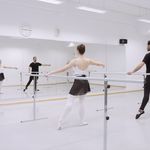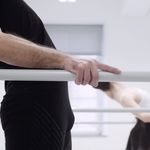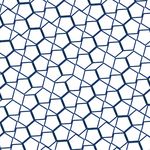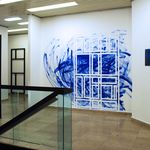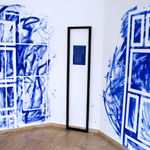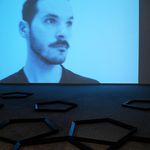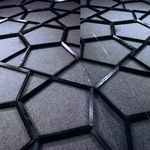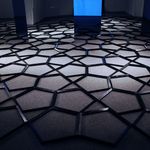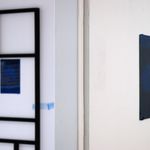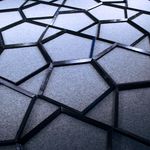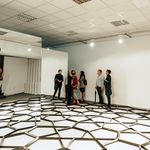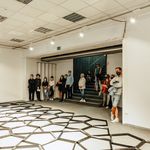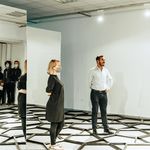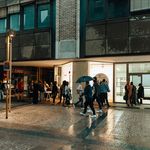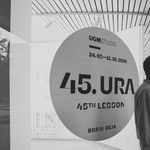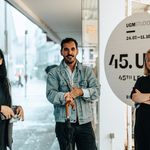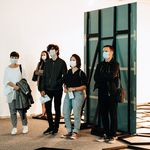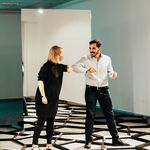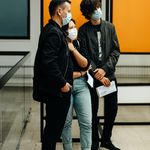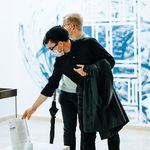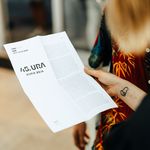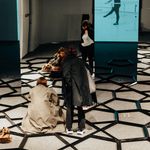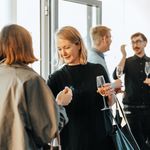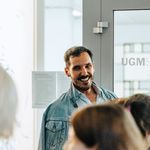Boris Beja / Lesson 45

Boris Beja / Lesson 45
UGM Studio, Trg Leona Štuklja 2
24 July − 11 October 2020
opening, Friday, 24 July 2020, 19:00
curator: Simona Vidmar
Similarly as his other projects, Boris Beja’s latest multimedia installation Lesson 45 that premieres at the UGM Studio, derives from personal experience and confrontation with one’s everyday life, translating them into broader encounters with social, cultural, or political phenomena. The initial point of this project was the artist's recreational attendance of ballet classes for beginners. Through elemental pole exercises in a mirrored training hall, he was learning for two years the fundamentals of ballet language and the steps to overcome the limits of physical performance under the watchful eye of his own control and self-criticism. He recorded the last, 45th lesson, in a video (Lesson 45, video, 2020, 45 min).
The artist used one of the main ballet exercises—Rond de jambe par terre—in which the dancer draws a virtual semicircle on the floor with his toe to the extreme capacity of the movement, as a starting point for the basic structural element of his installation—the "rond" (circle). It consists of a series of identical, hand-made pentagons arranged into a raster or geometric pattern on the floor of a simulated training hall. The pentagon unfolds as a pattern throughout the gallery and becomes a parkour for the participatory involvement of the viewer as a random actor in a spontaneous choreography. The source of the Lesson 45 audio-video impulses, which is hidden behind the mirror, can only be reached with artful movement through the intertwined network of "ronds". The repetition of ballet rehearsals is reflected in the repetition of the form, the art object; the repetition of the form creates a new space of movement and synchronisation. (Rond de jambe par terre, 2020, installation [wood, mirror], variable dimensions)
The "rond" is also a synonym for the outlines and limitations of the body, which is being delineated and at the same time annihilated by the classical ballet. Ballet techniques make it possible to discover the extreme limits of body coordination and the synchronisation of arms, head, eyes, and legs, and seemingly transform complex movements into perfectly natural ones. Through motion, especially classical motion with its positions, angles, and symmetries, and through the relation of the moving body to other bodies and space, we sense the presence of "intuitive body geometry". The body in motion outlines (geometric) shapes and compositions, which at the same time delimit the body itself. This Forsythean idea of dance as depicting geometry in space resonates in the second part of the installation, which Boris Beja titles after another ballet exercise—Doublé, battement divisé en quarts. The screens with recognisable Mondrianian coloured squares delimited by straight lines, appear on the one hand as a reference to modernist structural elements, which can be found in the artist's practice in various roles as supports and partitions, and on the other as parts of the scenery that with their strictly mathematical appearance introduce the element of theatricality and dramaturgy into the setting. They illustrate the relationship between movement and space, between dance and architecture. (Doublé, battement divisé en quarts, 2020, installation [wood, chipboard, glass, paper], 220 x 90 x 50 cm)
What Beja has “frozen” in his latest project is the motion image. What he has pursued (and symbolically mimicked in his facial expression in the Lesson 45 video) is perfection. Ballet is a symbol of perfection and perfection (according to Nureyev) is the duty. Or as Beja dramatically writes: “Perfection is the charm of ballet. And the thought that movement is controlled up to the sensation of pain in every muscle of the body, which is stretched like a string, while creating the impression of lightness as if hovering in space following imaginary coordinates of a feather in vacuum." The still images created and masterfully handled by the artist reveal that it is the syntax of the language that interests him and dictates the form. The language or the way one speaks that language and with it approaches the ideal, is the artist's prime concern.
Two interesting reflections on movement and performativity are opened up by Lesson 45, which the artist (perhaps intentionally) manages to address with his motion image. The first reflection relates to the attitude of the modern human towards movement. In later or rational life, the human becomes more cautious, suspicious, or even hostile towards movement, and forgets that movement is the basic experience of existence. “We forget that life is movement and that movement is life” (Rudolf von Laban, The Language of Movement, 1974). We lack the experience of the joy of movement as a spontaneous life action. Therefore, such an action must be re-created, so to speak, artificially, which the artist manifests by inviting the viewer to co-create a "rondoid" choreography. The second reflection is related to the transformation of art since the second half of the 20th century towards the uniform tendency of performativity of artistic actions, where the boundary between art and life is blurred. It is about the awareness “that the production of our subjectivities takes place precisely in the performativity of everyday cultural and institutional practices. That we are, so to speak, mass-produced through the daily implementation of scenarios which we include in our unconscious modus operandi as a kind of second nature” (Eda Čufer, Writing Movement, 2010). The immanent aesthetics of life and its performativity are the aspects upon which Beja's latest work as well as his previous projects are based. It is a perfectly "frozen" moment of Lesson 45!
(Text: Simona Vidmar, curator at UGM)
Boris Beja (b. 1986) graduated in 2009 from the Faculty of Natural Sciences and Engineering in Ljubljana, specialising in graphic technology, and continued his studies at the Academy of Fine Arts and Design in Ljubljana, where he graduated in sculpture in 2013. He received several awards and nominations for his work, such as the Student Prešeren Award for Sculpture (Academy of Fine Arts and Design) and the Award for the Contribution to Sustainable Development bestowed by the Public Fund of the Republic of Slovenia for Human Resources Development, both in 2012. In his work, he combines various art practices into an aestheticized appeal and social critique that expose the symptoms of contemporary society. In the period 2010-13, he regularly published articles on visual culture on the Siol.net portal. In 2014−17, he was assistant artistic director of the Škuc Gallery. Since 2017, he has been a professional adviser for cultural programmes at the Pionirski dom Public Institution. In recent years, he has held several solo exhibitions and participated in numerous group shows at home and abroad. In 2015 and 2016, he was nominated for the OHO Group Award, the main award for young visual artists in Slovenia. In 2017, he received the First Doris-Wuppermann-Stiftung Prize from Munich for his Space in Between project in Leipzig. He lives and works in Ljubljana.
The artist thanks the supporters of the project Nadja Černe, Črt Potočnik, Sanja Nešković Peršin, Pirueta Ballet School, and Anton Beja.
